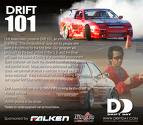


Have fun and start off with some RC drifting. . .with about 80 to 100 bucks you'll be sliding sideways. . .
--------------------------------------------------------------------------------
RC Drift Technique
Feint drifting Technique
Feint drifting is a widely used style. The professionals use it to break traction and even you now can imitiate it like a pro. The following steps will teach you the necessary steps to follow, to learn a basic drift maneuver. The steps are as follows and are performed by a stock Tl-01.
1. Get your car up to speed, or what you're comfortable with for the corner.
2. Turn yourself towards the outside of the corner.
3. After a split second of turning, turn sharply to the inside of the corner.
4.Once your rear begins to slide, counter steer or steer towards your rear, but not too much causing it to come around again and hit a wall.
5.After you complete the corner, lessen the throttle, or add more counter steer to end the drift.
6. Feel proud after you stop your car, because you have just learned a drift technique from the professionals themselves.
Uses: For high after long corners where you're too fast to turn, and for tight "S" type curves
--------------------------------------------------------------------------------
Front one way vs. ball diff.
There are various techniques which I have adopted for my style. First off, consider that I run a front one-way differential, and a very tight rear ball-diff. I would say that the output ratio is about 50:50.
I would first off say that when fully releasing the throttle at a general fast speed, a chassis equipped with a front one-way would induce the rear to swing out significantly during a steer in. The simultaneous actions of releasing the throttle (and allowing the rear to "lock up"), and steering into a turn, the initiation of the slide is apparent. This behavior is normal for cars equpped with front one ways. Some will agree that one-ways have an advantage for extremely complex technical tracks, especially with short S turns. Another advantage is that if needed to correct an angle assuming that you missed your ideal pivot line of a turn, a driver with a one-way can hit the brake to swing the rear out in order to correct an angle so that you can complete a hard corner rather than plowing into a wall. Although, initiating drifts by taking advantage with a one-way, if not perfected, choppy drifts may be the result. Car's with a front ball-diff tend to behave more fluent during drifts, but unfortunately suffer from understeer as compared to a car with a front one-way.
Other than inducing the drift by means of throttle off/braking drift with the front one-way, I usually power over into turns. This is my dominant technique for long sweepers of medium turns. During the mid drift, I pulse the throttle depending on how much I need to break the ABS from the surface or on how much I need to correct the angle. I will never completely release the throttle unless a critical angle correction is needed.
I think we all know that excessive counter steering should be used seldomly given that our 4wd drivetrain minimizes the necessity of extreme countersteer. I've noticed that most of us countersteer fully when they prevent themselves from spinning out during corners where the car untered beyond the ideal angle. Most times, drivers let the rear "steer itself".
--------------------------------------------------------------------------------




No comments:
Post a Comment